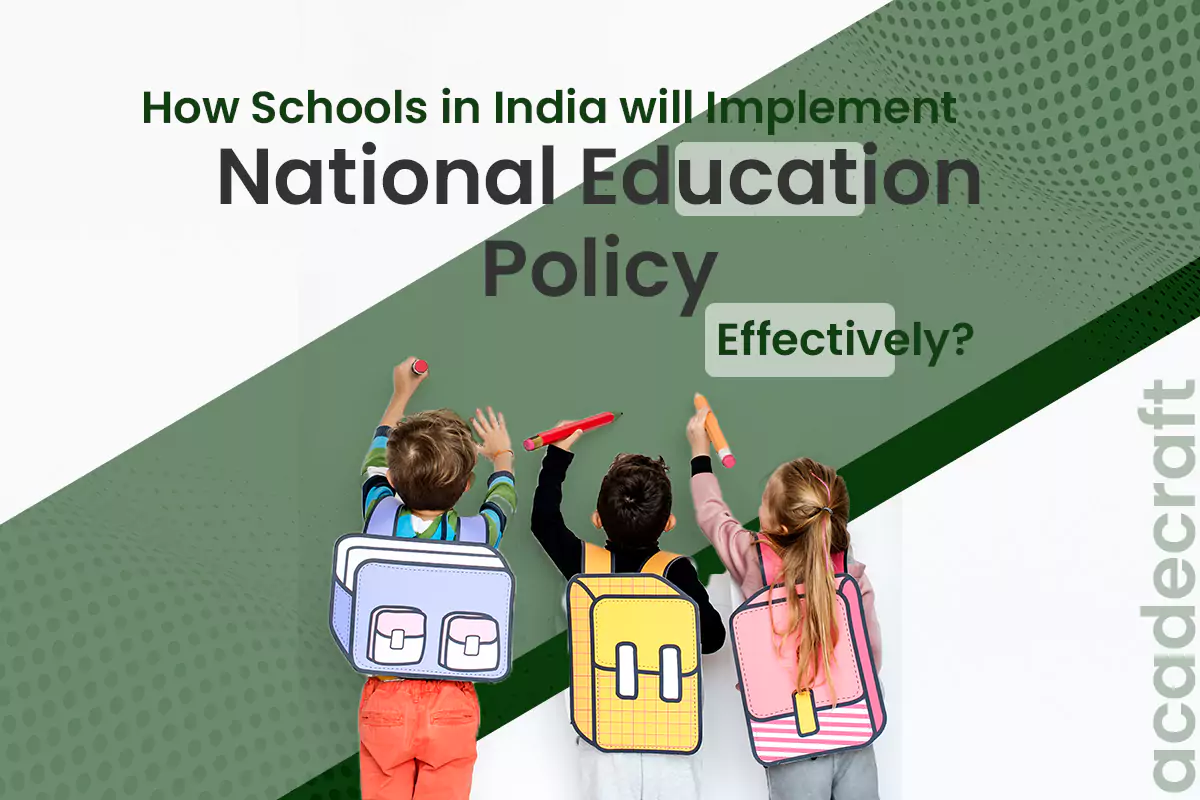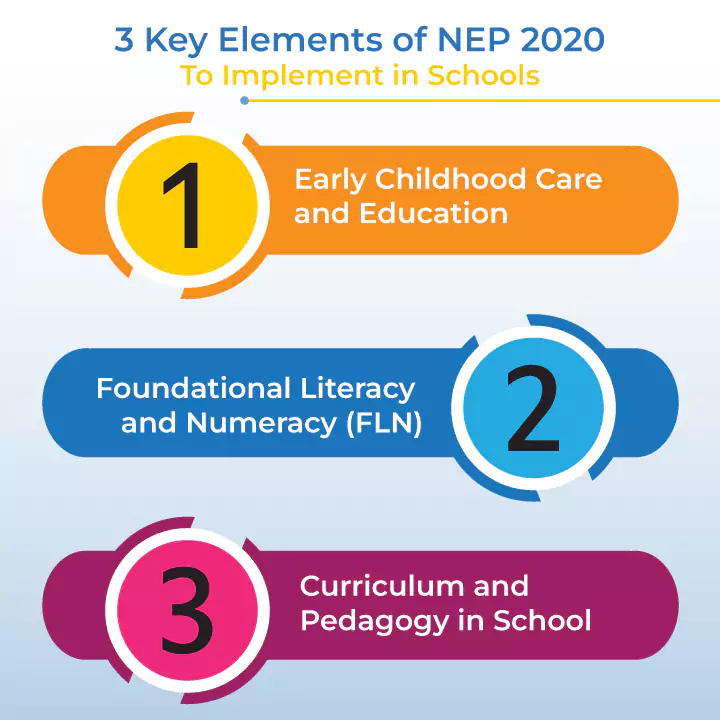
The National Education Policy is practical, visionary, progressive, and comprehensive. It has a broad scope from early childhood to higher education, professional education to vocational education, and teacher training. It is based on the ground reality of the nation's education scheme, which emphasizes creativity, innovation, and personality.
However, one major question stuck in everyone’s mind is how to implement nep 2020 in schools. This blog will discuss various measures for implementing NEP 2020 in schools. The policy is a significant upgrade under the Indian education system. It aims to make education more accessible, equitable, and relevant to the needs of the 21st century. The NEP has many key features, including:
The NEP is an ambitious plan, and schools in India will need time to implement it effectively. However, here are a few suggestions for the implementation of nep 2020 that schools need to adopt to get started:
Teachers need to be trained on the new curriculum and education scheme. This training should be ongoing so that teachers can continue to learn and grow.
Professional development for teachers is important for the success of students. It helps teachers stay current with current best practices and technology and allows them to understand their students' needs better.
For example, professional development workshops could focus on teaching strategies for engaging students with different learning styles or introducing new technologies to the classroom.
This strategy can also benefit teachers in terms of job satisfaction and morale. It can provide new ideas and inspiration to help them stay motivated and engaged. Professional development of teachers can create a sense of community among educators, allowing them to network and share ideas.
Textbooks and other learning materials must be updated to reflect the revised curriculum. It will require a significant investment, but it is essential for ensuring students have access to the best learning resources.
Such an investment is well worth it, as it ensures that students can access the most current, up-to-date material and benefit greatly from their studies. It is similar to investing in the maintenance and improvements of a house.
Updated textbooks and learning materials are necessary to keep the house up-to-date, with modern amenities and improvements, to make it livable and ensure the safety and comfort of its occupants. Similarly, investing in updated textbooks and learning materials is essential for providing students with the best learning resources.
Schools must create a supportive environment for students to feel safe and respected. It includes providing access to resources, such as libraries and computers, and ensuring that there are no barriers to learning, such as bullying or discrimination.
According to a survey, 95% of 3- to 18-year-olds have access to the Internet, with 88% having access through a computer.
This access to technology allows students to access educational resources and engage in learning activities outside the classroom. Furthermore, offering a supportive learning environment allows students to utilize psychological services and other resources that can assist them in academic success.
Schools must partner with the community to ensure all students have access to quality education. It includes working with parents, businesses, and other organizations to support students and their families.
It can be done by providing resources like tutoring, mentoring, and career development programs and offering connections to community organizations that can provide additional support. Ensuring equal access to possibilities and resources for each student, irrespective of their background or financial status, is a crucial aspect that we prioritize.
For instance, a school could partner with a local business that offers internships to students, providing an opportunity to gain real-world experience. By doing so, not only are students given equal footing, but they can also gain valuable work experience to help them on their path to success.
Implementing the NEP will be challenging, but it is essential for improving India's education quality. By taking the steps outlined above, schools can help ensure that the NEP is implemented effectively and that all students can succeed.
Bonus Read: When Will National Education Policy be Implemented in India?
The key elements of NEP 2020 to implement in CBSE schools are early childhood care and education, foundational literacy and numeracy, and curriculum and pedagogy. Let us understand each of them in great detail.

The purpose of NEP 2020 is to provide children with good-quality early childhood care and education between the ages of 3 to 8 years old. It includes the provision of play-based gamified learning and activities aimed at stimulating the child's physical, cognitive, social, and emotional development.
A significant investment in early childhood care and education (ECCE) provides the opportunity to provide quality education to young children. ECCE emphasizes various activity-based, play-based, and inquiry-based learning to keep young children engaged in the classroom.
In this setting, you can learn various useful skills such as arts and crafts, painting, drawing, the alphabet, numbers, drama, counting, music, and puppetry. The primary goal is to meet the set objectives for developing the body, the nervous system, and the brain. Socio-emotional-ethical development occurs concurrently with the role of mother tongue in education, communication, and literacy development.
A well-organized structure of early childhood education institutions would include the following:
As part of the initiative, existing Anganwadi teachers and workers will be trained in the NCERT pedagogical framework. Ashramshalas situated in tribally dominant areas will also adopt this new structure.
The initial eight years (ages 0 to 8) of a child's life are important for their development and growth. It is the time when the groundwork for holistic development and education is established.
Children who attend a high-quality preschool curriculum can help children achieve significant social, academic, and intellectual goals that differentiate them from those who do not attend preschool.
According to a study, adequate early childhood education programs lower the chances of dropping out and repeating grades while improving academic performance at all levels. Given the present struggles of education systems around the globe, it is important to identify which skills and developmental stages have the greatest impact on a student's long-term success.
To build a solid education system, having a well-funded public sector, ample human resources, and appropriate infrastructure is essential. Policymakers should prioritize increasing the budget for teacher training institutions and revamping their objective and authority to empower faculty and expand their freedom of work.
The mission has five main areas of focus. These include:
Many countries have shifted away from teaching, reading, and math in a step-by-step, skill-based manner to improve the quality of education. Instead, they focus on integrating these basic skills into a more comprehensive and contextual learning experience.
It means that students learn to read and do the math as part of a more expansive curriculum rather than as a separate prerequisite.
Here the focus is on the holistic, integrated, enjoyable, and engaging curriculum and re-structuring it in a new 5+3+3+4 structure. The new structure expands the scope of education beyond the traditional curriculum to include non-academic activities such as arts, sports, and vocational training. It is designed to provide students with a comprehensive education tailored to their interests and needs.
The education system is transforming itself for good. It aims at catering to individual developmental requirements dependent on their growth stages by following a structured approach.
The strategy adopted follows the "5+3+3+4" model, which includes four primary stages -
Each stage's curricular and pedagogical structure will be redesigned. For instance, Foundational includes Anganwadi/preschooling for two years and Grades one through two.
Preparatory consists of Grades three to five, while Middle covers Grades six to eight. Lastly, Secondary has two phases, one consisting of grades nine to ten while grades eleven to twelve are covered under another.
Read Also: 5+3+3+4 Formula Education System and New Exams Pattern | NEP 2020
As the National Education Policy has come into force, it was evident to discuss how to implement NEP 2020 in schools. This blog has discussed various suggestions and measures for implementing NEP 2020 in schools. It includes:
We have also covered the key elements of NEP implementation in CBSE schools which discussed Early Childhood Care and Education, Foundational Literacy and Numeracy (FLN)Curriculum, and Pedagogy in Schools. Nep content development is getting a wider popularity due to its emphasis on learners’ centric materials. Therefore, we have discussed the topic comprehensively.
The government also emphasized the assessment system, which focuses on experiential learning, critical thinking, and problem-solving skills. It also includes implementing integrated teaching methods like interdisciplinary and multidisciplinary learning. The overall goal is to create a stimulating learning environment for students.
Share